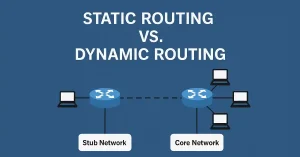Static Routing vs Dynamic Routing – Complete Explanation
Routing is the process of selecting paths in a network along which to send network traffic. It forms the backbone of all data communication in IP networks, enabling devices to exchange data across different networks. Routers, the critical devices in this process, forward packets based on the destination IP address, learning about remote networks through […]

